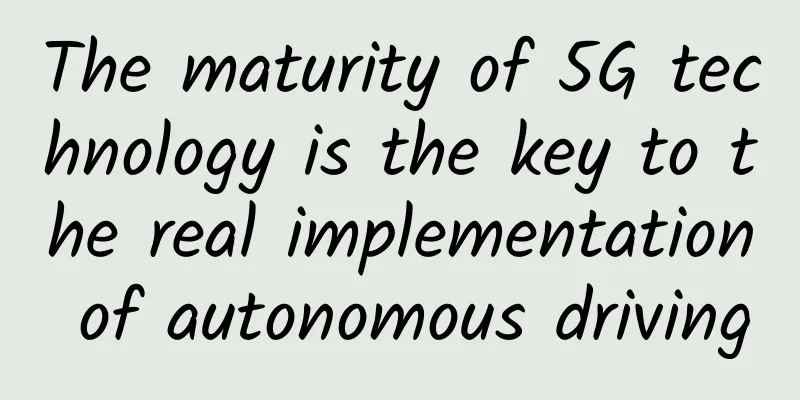The maturity of 5G technology is the key to the real implementation of autonomous driving

|
Recently, the news that "Huawei's Polar code has been selected as the control channel coding scheme for 5GeMBB (enhanced mobile broadband) scenarios" and "my country will launch the second phase of 5G network testing in 2017" spread like wildfire. For a time, the search index of "5G" soared to a new height. For ordinary people, what they care about is what convenience 5G technology can bring to daily life. For the smart car industry, what everyone cares about is what impact 5G technology can bring to the Internet of Vehicles and smart cars. Based on this, VehicleTrend (Wechat: vehicle-trend) analyzes the connections between the advancement of 5G technology and the Internet of Vehicles, smart cars and fully autonomous vehicles. 5G technology promotes the development of Internet of Vehicles In the industry, there is a widely circulated saying: "1G realized mobile calls, 2G realized text messages, digital voice and mobile Internet access, 3G brought picture-based mobile Internet, and 4G promoted the development of mobile video. 5G network is regarded as the foundation of the future Internet of Things, Internet of Vehicles and other interconnected things." There is an inevitable connection between 5G and the Internet of Vehicles. It can be said that how the Internet of Vehicles will develop in the future and in which direction will it develop? To a large extent, it depends on whether 5G technology can make breakthroughs. When it comes to the Internet of Vehicles, we have to mention LTE-V and DSRC. LTE-V and DSRC are the two major technology camps of the current Internet of Vehicles. The former is mainly promoted by domestic companies (Datang, Huawei, etc.), and the latter is dominated by the United States, Japan, Europe and other countries. LTE-V is a protocol specifically designed for vehicle-to-vehicle communication for intelligent transportation and Internet of Vehicles applications. Due to the limitations of communication technology, the current LTE-V version belongs to 4.5G technology. The realization of 5G technology in the future will enable LTE-V to evolve to 5G. DSRC, or dedicated short-range communication technology, is an efficient wireless communication technology that can provide high-speed data transmission and ensure low latency and low interference in communication links. LTE-V includes two working modes: centralized LTE-V-Cell and distributed LTE-V-Direct. Among them, the LTE-V-Direct mode can extend the vehicle perception range to hundreds of meters, which is a great advantage compared with the detection range of current vehicle perception systems such as radar and optical cameras. DSRC is an efficient wireless communication technology developed based on the IEEE802.11p standard. It can realize real-time, accurate and reliable two-way transmission of images, voice and data within a small range. At present, DSRC is more mature than LTE-V and is the mainstream technology for Internet of Vehicles in Europe and the United States. LTE-V has not been fully validated in the market due to the undetermined standards. However, compared with DSRC, LTE-V has a longer transmission distance, wider channels, and better synchronization. With the further development of 5G technology, LTE-V will be able to evolve smoothly to 5G in the future. In summary, 5G technology promotes the development of the Internet of Vehicles. The maturity of 5G technology will help LTE-V gain a high ground in the competition. In addition, my country has recently launched the research and trial work on LTE-V wireless technology and frequency division, which shows that China has begun to comprehensively deploy 5G-based autonomous vehicle-to-vehicle communication technology. 5G technology accelerates the industrialization of smart cars Smart cars have advanced sensors (radar, camera), controllers, actuators and other devices, and realize intelligent information exchange between people, cars and roads through on-board sensor systems and information terminals. At present, the definition of smart cars in Europe and the United States is mainly advanced driver assistance systems (ADAS), on-board mobile applications and unmanned driving technology, and to a greater extent, they are combined with urban intelligent traffic management. Compared with traditional cars, smart cars emphasize entertainment, intelligence, and can provide more convenient services. Therefore, networking is an inevitable trend in the development of smart cars. As mentioned earlier, 5G technology promotes the development of my country's Internet of Vehicles. Since the Internet of Vehicles is the most basic stage of smart cars, the development of 5G technology will also further promote the industrialization of my country's smart connected cars. CCID Consulting, a research institute under the Ministry of Industry and Information Technology, predicts that by 2020, my country's automobile sales will reach 31.39 million units, with an average annual compound growth rate of more than 5%. Among them, the penetration rate of smart cars will reach 25%, and the domestic smart car market size is expected to reach 109.7 billion yuan. From the perspective of the industrial chain, terminal hardware manufacturers such as sensors, chips, network modules, and vehicle terminals are expected to benefit first. The huge industrial chain brings considerable economic scale. The rapid development of 5G technology will accelerate its application in the field of intelligent connected vehicles and further promote the industrialization process of intelligent connected vehicles in my country. In the next few years, the intelligent connected related industrial chain will usher in a period of rapid growth. It is believed that by then, intelligent vehicle technology will also achieve breakthrough progress. When 5G technology matures, self-driving cars will be born The Internet of Vehicles is the initial stage of smart cars, and fully autonomous driving is the final stage of smart cars. To achieve the ultimate goal of autonomous driving, it is inevitable to solve the problem of network delay. The current 4G technology has certain information delay problems, which are very dangerous for autonomous vehicles. Perhaps a brake signal sent half a second late may cause a serious accident. With the development of 5G technology, the signal delay problem is expected to be solved. On the one hand, 5G technology can allocate the network according to data priority, thereby ensuring that the control signal transmission of autonomous vehicles maintains a faster response speed. On the other hand, when two vehicles are driving, the efficiency of direct data connection at close range is much higher than that of communicating via base stations. 5G technology will allow close-range devices to communicate directly, which can greatly reduce the overall pressure on the network and reduce the average delay. Solving the network delay problem, the technical difficulties of self-driving cars will also be further solved, and the future intelligent networked cars will fully realize the intelligent information exchange and sharing between cars and people, cars and cars, etc. By then, a travel mode that combines safety, comfort, energy saving and efficiency will no longer be a dream. |
Recommend
[Black Friday] RackNerd: Multi-datacenter VPS annual payment starts from $10.88
RackNerd's Black Friday promotion has been la...
Average tariffs to drop by another 10%. Senior management has given operators another task target! Are you ready?
At this year's two sessions, the top leadersh...
Moving forward amid challenges: A review of the top ten events in the 5G field in 2020
Time flies, and in the blink of an eye, 2020 has ...
[Black Friday] Sharktech High-Defense VPS 50% off, $47.7/year-2GB/40GB/4TB/Los Angeles and other data centers
Sharktech offers special discounts for VPS hosts ...
Goodbye, 2G/3G is retiring
With the advent of the 5G era, there have been a ...
5G is not yet popular, but 6G is coming: Tsinghua University experimented with 6G at the end of last year, led by the vice president
Domestic 5G construction is still in full swing, ...
5G will revolutionize the Internet of Things, but not soon
5G technology is the most anticipated network upd...
Simple test of DogYun Korean data center elastic cloud server
The blog has shared DogYun product information se...
Advanced Web Essentials: Network Optimization, Use It to Impress the Interviewer
Preface I've been so busy lately, the app is ...
Wi-Fi 6 applications are in sight, which may trigger another wave of IoT development
Wi-Fi currently sends signals on the 2.4 and 5GHz...
Huawei launches intelligent network to unleash the power of ultra-broadband with intelligence
[51CTO.com original article] Hangzhou, China, Oct...
Just now! ZTE Announcement: Affected by the rejection order, the company's main business activities can no longer be carried out!
On the evening of May 9, ZTE issued an announceme...
These 6 ways to implement load balancing technology should not be missed
Load balancing is an application of cluster techn...
Learn crawling skills in Yiwen
[[336016]] Preface As an important tool for cold ...
Black technology! Disruptor! Blockchain, it’s too late if you don’t pay attention to it
In 2008, the concept of blockchain emerged. This ...
![[Black Friday] HawkHost: Cloud Web Hosting/Semi-Dedicated 70% off, Hong Kong/Los Angeles and other data centers](/upload/images/67cabcd62eb44.webp)
![[Black Friday] TNAHosting: $12/year KVM-1GB/15G SSD/5TB/Chicago](/upload/images/67cac00a526fb.webp)







